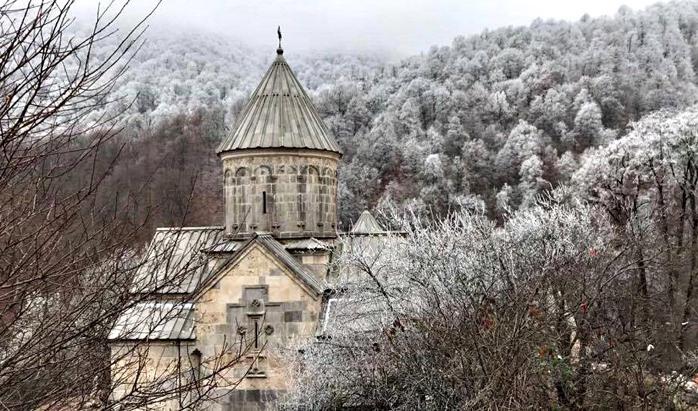-
 Viktorya Mirzoyan
Viktorya Mirzoyan

Armenian carpets / Photo: Viktorya Mirzoyan
Explore Armenian Rug Weaving Traditions and Get Unique Rugs with These Tips
Views - 4080
Carpets and rugs have long been a part of the Armenian cultural expression. Enter any traditionally decorated home in Armenia and one of the interior elements that first meets the eye is use of rugs and carpets in decorations. The more intricate and valuable pieces are usually hung on the walls, just like one would hang a painting. It represents the taste and the wealth of the host. So, are we just connoisseurs or are we a part of this art form that dates back to 500BC?
The oldest known carpet in the world, dating back to 500BC, was found in the area of the Altai Mountains in Siberia. It was hiding in the grave of a Scythian nobleman, which also indicates how valued such artwork was and continues to be. The carpet was later named Pazyryk after the name of the valley it was found at.

Pazyryk Rug / Photo: Viktorya Mirzoyan
What is so significant about this oldest piece of art is that, although debated by many cultures and hard to prove, many art historians and modern Armenian rug-weaving experts dispute that there are two factors proving the Armenian origins of the carpet. First, it is made with the use of the double loop technique, which is characteristic to Armenian ancient rugs, and second, the red color dye used represents Armenian ‘vordan karmir’ dye, which literally translates into “worm’s red," obtained from Armenian cochineal worm found in the Ararat Valley.
Whether or not we decide to go with one theory or another, carpets and rugs are a big part of the Armenian culture that started to revive and get commercialized more and more after the Soviet collapse. Companies were established that went the extra mile to research, revive, preserve and build upon the rug-weaving heritage. Ancient patterns and techniques characteristic of Armenian carpet-making were collected, coordinated and put into the basis of the high quality pieces made and sold in Armenia today.
If you’re visiting Armenia anytime soon and this ancient form of art is something you’d like to explore, we have collected some helpful advice on where, when and how to explore. Be sure to check out:
MEGERIAN CARPETS

Armenian rugs at Megerian Carpet, Yerevan / Photo: Viktorya Mirzoyan
Initially having launched its rug and tapestry business in the States in 1917, the Megerian family represents a workmanship benchmark for oriental rugs and tapestry production. Megerian Carpet in Armenia is not only a place where you can purchase these superb handmade pieces from traditional to modern, but where you can also take a tour and explore the entire process of their making and learn the history of this craft at their factory in Yerevan.
At their specialized store in the heart of the city on the intersection of Abovyan Street and Northern Avenue, you can also see the copy of the above-mentioned Pazyryk rug, the original of which is now in Hermitage.
At the showroom shop you can see famous Armenian Nshagorg (literally translated Almond Carpet), which signifies fertility and used to be given as a present to newly-wed women. Back in the days, young women, who were to get married, wove this carpet themselves to take to their new home with them for good fortune and to bring luck to the new family. The pattern on the carpet resembles a woman with a womb carrying the offspring.

Nshagorg - Armenian "almond" carpet / Photo: Viktorya Mirzoyan
Another beautiful carpet story I was told at the showroom is that of Vishapagorg (literally translated — dragon carpet), which portrays dragons that symbolized warriors in ancient times. Having this carpet at one’s home was meant to protect the house and the family from enemies and bad spirits.
The peculiarity of Megerian carpets is that they are made of 100% natural components, including materials and dyes used. The prices start from 25,000 AMD (around 60 USD) and can go up to 4,5mln AMD per square meter depending on the intricacy of the weaving.
Address: 9 Madoyan Street | Phone: (+374 11) 442-994 | Website
TUFENKIAN CARPETS

Tufenkian artisan carpets, Yerevan / Photo: Viktorya Mirzoyan
Tufenkian Artisan Carpets was founded in 1994 with the vision to collect and preserve the Armenian heritage of carpet-weaving and also maintain traditions by providing workplaces to professional weavers.
Having their headquarters in New York and over ten branches in the States, Europe, Nepal and elsewhere, the factory in Armenia focuses on production of rugs that represent the Armenian techniques and patterns, as well as build upon them with newer styles and designs. The company employs highly professional design artists and best in the industry weavers. Tufenkian artisan rugs can be found in four corners of the world with one of the most intricate and expensive pieces having found home at the premises of Washington Congress.
The rugs are made mainly from wool for Armenian carpets and silk is also used for other designs. The distinguishing quality of Tufenkian carpets is that they are 100% handmade, which implies that the threat that goes into making the carpet is also weaved by hand. Prices vary from 255,000 to 400,000 AMD (around USD 530-830) per square meter based on the intricacy of the design and thickness required, as well as consequently the amount of work done on the piece.
Address: 48 Hanrapetutyan Street | Phone: (+374 98) 559-959 | Facebook page
VASILYAN'S ANTIQUE GALLERY

Armenian carpets at Vasilyan's Antique Gallery / Photo: Viktorya Mirzoyan
Vasilyan’s Art Gallery is a result of the collection of ancient rugs that the owner Stephan Vasilyan started enriching since 1967 with rugs Kazak, Gandje, Karabakh Shirvan and Kuba regions. You can find rugs dating back to the 19th and 18th centuries sold here. Nowadays the gallery’s main function is to discover ancient rugs made and preserved in the regions of Armenia and offer them for purchase in their specialized gallery-shop.
For 20 years, the gallery has been functioning on Abovyan Street of Yerevan, offering ancient and modern rugs from Zangezur, Artsakh, Lori, Gegharkunik regions that are made by individual carpet-weaving professionals. The prices vary from AMD 30,000 to 400,000 (around USD 70-830) per square meter.
Address: 2/5 Abovyan Street | Phone: (+374 91) 402-142 | Website
This is just another magical aspect of Armenian culture. Visit these galleries, take a tour in the factories, get yourself a piece for memory or simply enjoy this ancient art form during your visit to Armenia.











